Invisible Cities: Part Two: Hunger
By Javed Iqbal
16 November , 2010
MoonChasing Blog
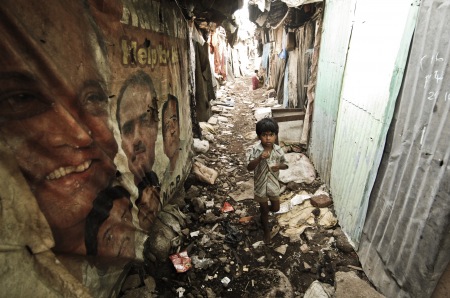
This article appears in The New Indian Express on the 14th of November, 2010.
Malnutrition is not just a rural phenomena but is even unchecked amongst the poorest sections of the urban population. While access to development is often cited as a cure to the ills of hunger, there are many people living in Mumbai, deprived ‘access’ to development – healthcare and basic human rights .
Read Invisible Cities: Part One : A Short History Of A Slum
Rafiq Nagar 2 is just one of the slums built on the Deonar dumping grounds of Mumbai. Around 6000 metric tonnes of garbage is dumped daily at Deonar while the daily-wage earners or scavengers of Rafiq Nagar 2 sift through the hills of trash to earn a living.
Layers of plastic make the foundations of homes, old political posters, tin sheets, canvas and cloth make the walls, and decomposing condoms litter the pathways. At one corner, young children sell expired chips covered in swarms of flies for Rs.1 a packet. Other children were buying them and consuming them. They had found them at the dumping grounds.
Over the last two years, 23 children of Rafiq Nagar 2 have died of malnutrition-related causes or at childbirth itself.
On the 9th of September 2009, Munni Hasan Sheikh was refused admission to Sion Hospital for want of space, and she gave birth at the gateways of the hospital. The child died within a few hours.
Shamshad Begum lost both her twins, weighing a kilogram each – one died at childbirth at home, another only lived for two months at KEM hospital.
And yet, a majority of the women refuse to go to the hospital – they’re afraid of leaving their homes without doors or window, for fear of being robbed of their measly possessions by their neighbours – drug-addiction and delinquency is rampant at Rafiq Nagar 2.
Another 14 children died of pneumonia, dysentery and malaria – all were underweight children. The breadwinners themselves work as unskilled labour or as ragpickers, themselves at the risk of tuberculosis infection due to the high levels of toxicity emanating from the overused dumping grounds themselves. Mohammed Mubeen earns Rs.200-250 a day and there are seven people in his house.
Saira Ansari’s two children suffered from malnutrition, and her tiny 4’9 frame is symptomatic of one the major problems of nutrition – that the mother’s were previously malnutrition children themselves. Yet her oldest daughter Saina has now recovered from Grade 3 malnutrition. She was treated by an NGO Apnalaya, that provides nutrition to some 394 other children of Rafiq Nagar 2. There is no ICDS yet.
‘I have been working in the slums for 30 years now,’ Says Leena Joshi, Director of Apnalaya, ‘Earlier the government was sympathetic to the needs of the poor, and now they ask me why I am helping them.’
‘I was asked to stay at home today because we heard the BMC is coming to break down our homes,’ Said Mohammed Younis Khan, an auto-rickshaw driver at Rafiq Nagar 2.
The slum is illegal and the constitutional right to a livelihood and to a home, belongs with the trash of Mumbai at the Deonar dumping grounds. Most of the tenants settled at Rafiq Nagar 2 beyond the magic cut-off year of 2000, a majority are landless from Uttar Pradesh and Bihar – the MNS’s most unwanted.
At the same time, people do not have access to clean drinking water. They have to buy it for Rs.20 a can from the ‘water mafia’, and usage depends on affordability. One woman claims her house has to do with three cans a day.
Mohammed Alam Hashmi is a landless labourer from Pratapgarh, Uttar Pradesh with habitual complaints of the Thakur landowners who renege on their payments. He has three children, including eight year old Zahid Hashmi who lost his eyesight a year ago. He is the only earning member of his family who works as a labourer as his wife now needs to spend her time tending to the needs of her disabled son, Zahid, who, without eyesight spends most of his time in the dark of their home. At the same time, there are his medical expenses – his father has to find a way to buy him Ethionamide, Ofloxacine, Kanamycin and Quinoline. He is being treated for tuberclosis, another problem endemic in Rafiq Nagar 2.
His sister Soni is another child who recieves nutrition from Apnalaya.
And again, there are few ration cards between the people of Rafiq Nagar, with a majority of households having applied for a card but have received nothing so far. Recently, the National Advisory Council, proposed the Food Security Bill, which considers subsidy grain for 75% of the population – categorized under ‘priority’ households and ‘general’ households. As it is, the following entitlements were dropped or diluted from the proposed Act: creche facilities for working women; social security pensions; nutrition supplements for adolescent girls; and ICDS entitlements not already included in Supreme Court orders.
And there are strong voices of dissent against the act and it’s intent to continue with targetted PDS.
‘Everytime the government says it wants to strengthen the PDS, but its actions just weaken it.’ Says Leena Joshi, who is also involved with the Right To Food Campaign.
The Right To Food Campaign itself has called for universal PDS. The logic being, the rich don’t use the PDS system, the poor do. And targetted PDS has proven counter-productive, repeatedly, as in the case of the people of Rafiq Nagar 2, who don’t have an ICDS, nor ration cards, who’re poor enough to starve, but not poor enough to get the government to recognize their poverty.
Youth Without Youth
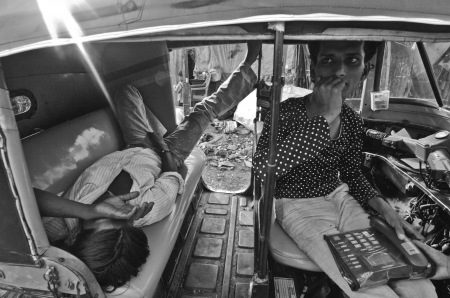
Twenty-six year old Rafique (name changed) started taking ‘charas’ when he was eight years old. He claims to have been in jail repeatedly, from a rape case to being a pickpocket. His father died young and he and his mother were thrown out of their home at Dharavi by his uncle.
‘I don’t want to scare you,’ He says, ‘But there was this one photographer who had come here a while ago. A ‘gora’ whose wallet was full-packed. And there was this Bihari boy with me, and he decided we’d take the wallet. We thought it would be full of dollars.’
‘So anyway, we tore out the pocket, got the wallet and ran, but there were only tickets in the damn wallet. So we just threw it away.’
Both his arms have over numerous scars from a blade or a razor, running across from his elbow to his wrist. Sitting next to him is S, an alcoholic, and both her arms have similar scars. Rafique hints that S sells drugs and alcohol to people in the nearby slums.
‘There’s also a lot of murder here,’ he continues, ‘Just yesterday someone killed someone.’
‘Why?’
‘Family dispute.’
At another part of the slum, a 12 year old boy cries continuously, while his mother furiously screams, expressing her anger while a crowd gathers. Apparently a few older boys had beaten up the young boy at the dumping grounds. Cause unknown.
The alleged culprits sit at the edge of the dumping ground – six young boys sit under a tarpaulin makeshift shelter, smoking ‘charas’ allegedly smuggled from Rae Bareli, while their neighbour complains discreetly, admittedly afraid, ‘Something has to be done about them. They harass everyone in the slum.’
‘Someone has to talk to them.’
Pushpa, a social worker with Apnalaya tells him that they will send someone who knows how to deal with the boys.
‘They’ll even give me hell for talking to you.’ He said.
‘Tell them, you were just complaining about the BMC.’ I replied, he laughed, ‘That’s a good idea.’
Rafique meanwhile has ‘cleaned’ up. He got married a year ago and has a steady job now. He manages to make ends meet, working in a shop, to support his wife and his mother. But then there is the police.
‘They still harass me, anything happens and they show up at my house,’ Says Rafique, ‘Even in the middle of the night when I’m sleeping, they’d come.’
At another end, Hamida, is a social worker at Apnalaya as well as a tenant at Rafiq Nagar 2. Her husband is a labourer, while she taught herself to read as a child.
‘I used to go to the teachers and force them to teach me.’
She spends her day at the Apnalaya center, weighing the children, marking their progress, from Grade 3 malnutrition to Grade 2, to Grade 1, writing report after report.
She accompanies me to meet the mothers and children of Rafiq Nagar 2 – we go specifically to look for people who didn’t have ration cards, who worked as informal labour, and whose children were underweight – a vast majority of them.
‘How old is your daughter?’ I had asked Saira Ansari, ‘Five.’ Her mother replies, as Hamida instantly corrects her, ‘No, she’s four and a half.’
The mother laughs. So does her daughter, Sania who entangles herself in her mother’s maxi, giggling away. She’s three times her bodyweight now, receiving nutritious food from the NGO.
Healthy.
Photography Post-Script
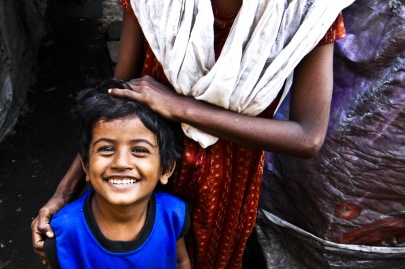
Sania with her mother.
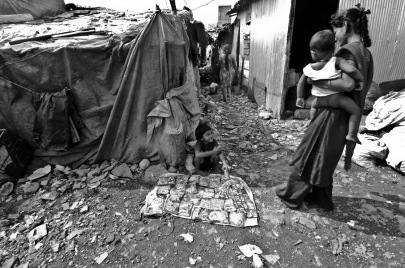
A young girls sells expired chips, found on the dumping grounds, for Rs.1 a packet.
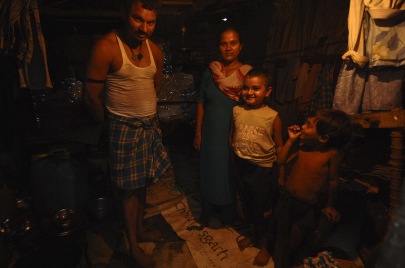
Zahid Hasmi (second from right) with his father, mother and sister in their house in Rafiq Nagar 2.

